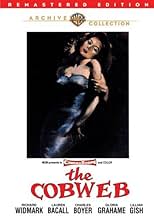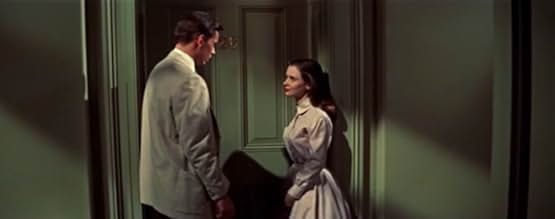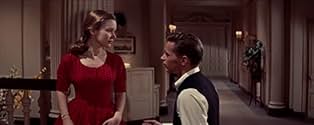Füge eine Handlung in deiner Sprache hinzuAt a private psychiatric clinic, the daily dramas and interactions between the doctors, nurses, administrators, benefactors and patients are accentuated by the personal and family crises of ... Alles lesenAt a private psychiatric clinic, the daily dramas and interactions between the doctors, nurses, administrators, benefactors and patients are accentuated by the personal and family crises of these individuals.At a private psychiatric clinic, the daily dramas and interactions between the doctors, nurses, administrators, benefactors and patients are accentuated by the personal and family crises of these individuals.
Empfohlene Bewertungen
What's interesting is that there is no antagonist; like "Howards End" or Eastwood's "Unforgiven", all the characters do bad things for understandable reasons and thus construct the cobweb. This compares favorably with other nuthouse movies, especially ones about the group therapy system--"Cuckoo's Nest" (based on Ken Kesey's novel of 1950, 5 years before "Cobweb") and "The Caretakers" with Joan Crawford as the inflexible head nurse. Those films tend to focus on patients having hysterics and running riot. They don't indict the system but one despotic individual within it (a head nurse); Kesey's narrator claims that she represents a larger controlling force but even then shows that other wards in the hospital are not the same. However, "Cobweb" takes a more subtle nobody's-fault approach that ultimately has wider, darker implications. It implies that these pitfalls are endemic to the system because they are part of human nature, which is a more sinister idea (especially for the 50s) than being able to blame a convenient mini-Hitler. Therefore, it works more convincingly as a microcosm of a society that thinks it's healthy. It's also more salutary and hopeful than those films because it proceeds from this clear-eyed cautionary assessment.
In the true sense of "melodrama," it underlines apparently innocuous early scenes with heavy foreboding music by Leonard Rosenman. It's also astonishing to watch Lillian Gish play a b----. And she does a great job.
As I recall, the movie got promoted on the basis of its marquee cast, including the classic Lillian Gish making her first appearance in a number of years. The large number of names, of course, required the script be extended so that each star would get an appropriate amount of screen time. This results in a number of subplots and an over-stretched 2-hour-plus runtime, way more than the slender who's-going-to decide-the-draperies premise can sustain.
However, unlike most reviewers, I don't object to the running issue of the curtains, ridiculous as it sometimes seems. After all, this is an institution for troubled people including the staff, so they may well obsess over something seemingly as minor as a decoration. Then too, who makes the decision serves as a catalyst for bringing out the various unresolved conflicts among the residents. I just wish the surrounding drama was better written, acted, and directed. Certainly, the talent was there to do just that. Instead we're left with a film that remains obscure for good reason.
Minnelli uses a bit of the soundtrack of Seven Brides For Seven Brothers, here (the picture that trumped his own Brigadoon at the box office) - in a scene at the movies. Guess he had no hard feelings.
One of Minnelli's interesting misfires. Even though it doesn't really work, I've seen it three or four times.
The acting is good, overall. Richard Widmark (as the director of the clinic) has two leading ladies, Lauren Bacall and Gloria Grahame. This is one of the few times I've ever really seen Grahame miscast. She had a wide range, after all she played everything from Violet Bick in It's A Wonderful Life, to Rosemary Bartlow in The Bad And The Beautiful, to Ado Annie in Oklahoma. But I think you will agree her role defeats her best efforts here. She starts out very well but I'm not sure I always understood where she was coming from as the film wore on. Bacall plays a simple, sensible girl, and does a good job. Lillian Gish plays the unpredictable Miss Inch, Charles Boyer the self-destructing Dr. Devanal, John Kerr the young and artistic Stevie (a role originally announced for James Dean). Oscar Levant is called upon to go outside his usual comfort zone and I'm not sure he makes it. Susan Strasburg is excellent in a small role.
How it ever got the green light from the studio is mystery number one, that Vincente Minnelli said okay to directing it is the second although that would explain why so many great actors allowed themselves to be involved.
Everybody gives overheated performances except Lauren Bacall who keeps a low-key dignity amongst the melodrama and Susan Strasberg offers a restrained quiet portrait of a shut-in who is making her first tentative steps towards reemerging into the world.
The rest of the players aim for the rafters to varying degrees from Richard Widmark's impassioned but distracted doctor who is merely agitated then there is Lillian Gish who chews a bit of scenery as a bitter spinster as well as many other respected actors who show little restraint.
The real standout though is Gloria Grahame as Richard's hot mess of a wife, she seems to realize how silly the whole thing is and pitches her performance to that tempo, she's jittery, flouncy and fun plus she looks great.
Laughable take on mental health but good for one fun viewing as a camp catastrophe.
Wusstest du schon
- WissenswertesMarks the return of Lillian Gish to MGM after a 22-year absence. The Cobweb was Lauren Bacall first film for MGM.
- PatzerWhen Karen (Gloria Grahame) storms into her bedroom and kicks off her shoes, she apparently launches the first one over the walls of the set, as it shoots straight up toward the supposedly low ceiling but never comes down.
- Zitate
Steven Holte: Artists are better off dead.
Karen McIver: Why?
Steven Holte: People pay more attention to them when they're dead. That's what's so troublesome.
Karen McIver: Is that what you are, a painter?
Steven Holte: They said Van Gogh was crazy because he killed himself. He couldn't sell a painting while he was alive, and now they're worth thirty million dollars. They weren't that bad then and they're not that good now, so who's crazy?
- VerbindungenFeatured in Point Blank - Keiner darf Überleben (1967)
Top-Auswahl
Details
- Erscheinungsdatum
- Herkunftsland
- Sprache
- Auch bekannt als
- The Cobweb
- Drehorte
- St. Louis Street, Lot 3, Metro-Goldwyn-Mayer Studios - 10202 W. Washington Blvd., Culver City, Kalifornien, USA(McIver's neighborhood, demolished in 1972)
- Produktionsfirma
- Weitere beteiligte Unternehmen bei IMDbPro anzeigen
Box Office
- Budget
- 1.976.000 $ (geschätzt)
- Laufzeit
- 2 Std. 14 Min.(134 min)
- Seitenverhältnis
- 2.55 : 1





































